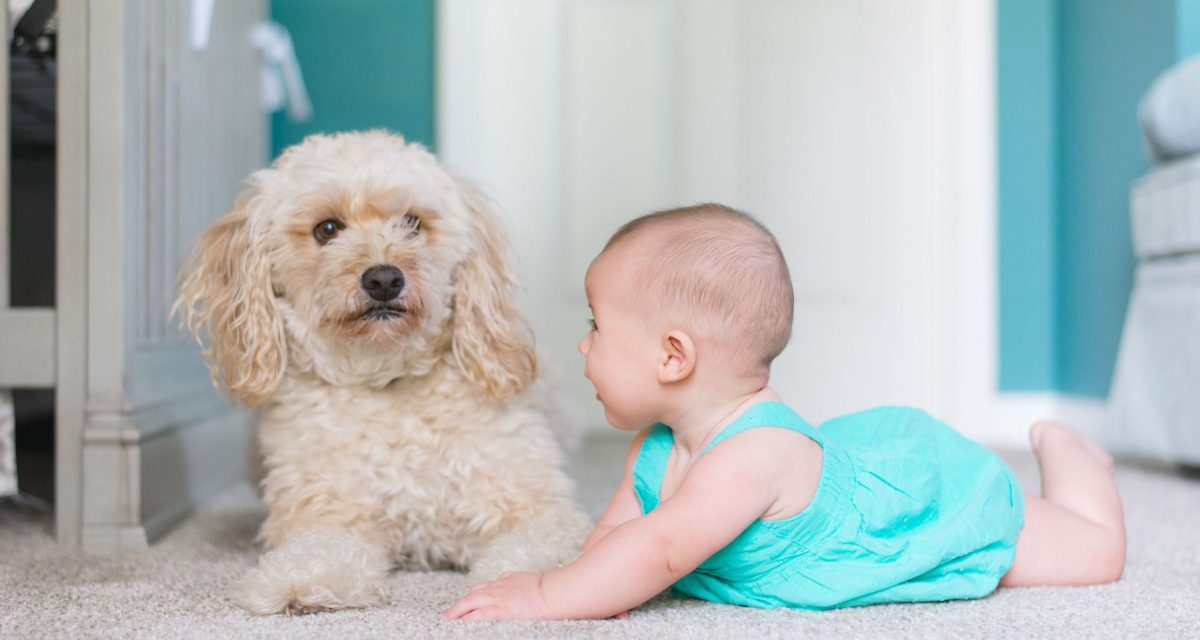It is important to remember that no child should ever be left alone with a pet; even the
“best” pet may hurt a baby. Close supervision is mandatory when an infant/toddler
and a pet are together.
- Anticipate schedule any household changes that may occur when the baby arrives; try to implement these changes well in advance of the actual arrival of the baby. This may mean spending less time with the pets, pet segregation from certain areas of the house, teaching the pet to stay off the furniture, awakening at night, etc.
- Practice Tranquility Training Exercises (see handout) with your pet prior to the arrival of the baby.
- Prior to the arrival of the baby, obtain a recording of a baby crying. One resource is www.soundsscary.com, Soothing Sounds CD with baby noises. Play on low volume for 5–10 minutes multiple times daily. During sessions, have the dog do basic obedience commands and reward good, obedient, calm behavior. Gradually increase the volume at successive training sessions until the recording is played at true baby crying volume. If at any time during increases in the volume the dog appears to be agitated, return to a lower volume and progress more gradually. It may be beneficial to start carrying around a baby doll and rewarding the dog for good behavior around the “baby.”
- Get the pet used to new baby product odors and furniture by having them in the house prior to arrival of the baby.
- Get pets used to pulling on hair/ears by initially doing it very gently and rewarding them for good behavior with a treat/affection. Gradually increase the intensity of the pulling until you mimic what a toddler may do.
- Do not allow pets to get into the crib or sleep in areas where the baby will be sleeping/resting.
- For particularly anxious dogs/cats, consider placing a canine pheromone product
- DAP (dog appeasing pheromone ) or
- Feliway (cat calming pheromone) diffuser in the house about 2 weeks before the baby’s arrival.
- After the baby is born, bring some of the clothing that the baby has worn in the hospital home for the pets to smell.
- When you bring the baby home, have another person hold the baby so that you can greet the pets.
- Once things have calmed down, introduce your pets one at a time to your new baby. The pet must be controlled during the introduction. Leashes and head halters or harnesses can be helpful. Have one person hold the baby while sitting comfortably on a chair. Another person should be carefully monitoring your pet’s behavior. At any sign of aggressive or unacceptable nonaggressive behavior (i.e., crawling on top of baby), interaction with the pet and the baby should be immediately interrupted. Aggressive behavior should result in immediate isolation of the pet and contact with your veterinarian. Unacceptable, nonaggressive behavior should result in redirection of the pet to do an alternative behavior (e.g., sit); desirable behavior is rewarded.
- If there is only one spouse at home during the first few weeks that the baby is at home, then the pets should be restrained or confined in the presence of the infant. Tethers, crates, or baby gates may be helpful.
- Usually when a new baby enters the household, the adults ignore the pets when the baby is active and give the pets attention when the baby is sleeping. Inadvertently this teaches the pet that the baby is something negative (baby equals no attention) and that the absence of the baby is a good thing. This is the opposite message that we want to give our pets. Therefore, make a point of trying to pay attention to the pets when the baby is active/present. This can be done with verbal engagement or if two adults are present, one adult can attend to the baby and the other adult can pet or play games with the pets. When the baby is sleeping, you should pay less attention to the pets.
Source: BLACKWELL’S FIVE-MINUTE VETERINARY CONSULT CLINICAL COMPANION





